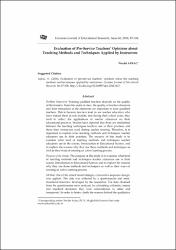Evaluation of Pre-Service Teachers' Opinions about Teaching Methods and Techniques Applied by Instructors
Özet
Problem Statement: Training qualified teachers depends on the quality of the trainers. From this point of view, the quality of teacher educators and their instruction in the classroom are important to train qualified teachers. This is because teachers tend to see teacher educators who have trained them as role models, and during their school years, they tend to reflect the applications of teacher educators on their educational practices. Studies have reported that there are similarities between the teaching techniques teachers use in their practices and those their instructors used during teacher training. Therefore, it is important to explore what teaching methods and techniques teacher educators use in their practices. The purpose of this study is to examine what kind of teaching methods and techniques teacher educators use in the course, Introduction to Educational Science, and to explore the reasons why they use those methods and techniques as well as their ways of creating an active learning process. Purpose of the Study: The purpose of this study is to examine what kind of teaching methods and techniques teacher educators use in their course, Introduction to Educational Science, and to explore the reasons why they use those methods and techniques as well as their ways of creating an active learning process. Method: One of the mixed model designs, consecutive sequence design, was applied. The data was collected by a questionnaire and semi-structured interview developed by the researcher. The data obtained from the questionnaire were analyzed by calculating arithmetic means and standard deviation; they were demonstrated in tables and interpreted. In order to better clarify the reasons behind the qualitative findings, quantitative data were collected and analyzed with content analysis. Findings: Findings show that student teachers reported that their instructors mostly employ question-answer, discussion, lecturing, brainstorming, group work, and individual or group presentations in their practices. Student teachers also reported that their instructors rarely use student-centered teaching methods including dram, educational games, concept checking, dramatization, aquarium, speaking ring, storytelling, station, conceptual, caricature, and tour. Findings from interviews with instructors show that class size and the physical structure of the classroom force them to use more traditional teaching methods in their practice. Other reasons they used more traditional methods were: a) lack of pedagogical content knowledge, b) the ignorance of the lesson, and c) the perception that university level course are taught in traditional ways. Conclusion and Recommendations: The research results showed that while teacher educators frequently use questioning and lecture techniques in their classrooms and they assign the students into groups or pairs and ask them to present what they learn from the groups, they rarely use other effective techniques such as concept controlling, educational games, drama, oral history, speech circle, writing story, or conceptual comics. Additionally, teacher educators contended that crowded classrooms, physical environments of classrooms, using traditional teaching methods, and not spending more time using active teaching methods negatively affect learning processes in classrooms. Considering the results of the research, it can be recommended that teacher educators attend courses related to effective use of active learning strategies in classrooms and get involved in professional development seminars concerning active learning strategies. Also, solving problems relevant to crowded classrooms, organizing an environment for active learning activities, and decreasing the number of courses teacher educators teach would make significant contributions to this process.


















